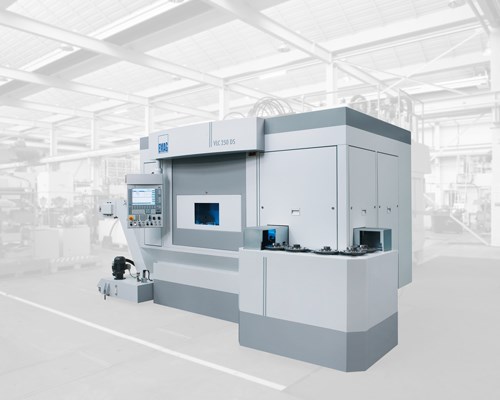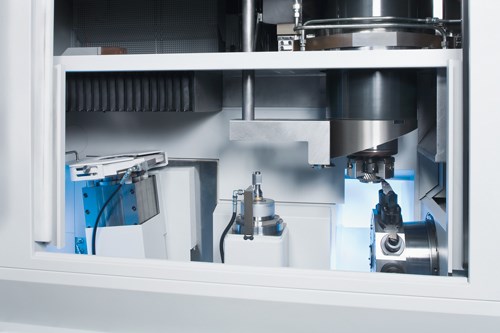Combining Hard Turning and Grinding
A combination machine that is capable of both turning and grinding work in a single setup might provide the capabilities a shop needs to address an ever changing work flow.
When a shop is in the market for new equipment, it generally has a certain need that a particular technology will fill. But over time, those needs can change, and certain specialized equipment may no longer be as useful to that shop. Today’s advanced technology allows machine tool builders to provide flexible, highly productive equipment that often gives shops multilayered capabilities. Such equipment allows a shop to adapt more readily to varying work. A machine designed under a platform concept—customizable for individual requirements while allowing simple reconfiguration for future demands—better prepares a shop for upcoming opportunities. During tough economic times, such features become even more important.
If a shop has sufficient capabilities for its turning requirements, but new jobs begin coming in that require some grinding work, the shop may find a need to invest in an additional machine. But if this grinding work is minimal and these workpieces are only produced in small or medium batch sizes, the purchase of a grinding machine may not be justified. A combination machine that is capable of both the turning and grinding work in a single setup could be the solution.
Blending Processes
EMAG now offers the VLC 250 DS turning and grinding center, combining the advantages of vertical hard turning with those of grinding. This machine is reconfigurable throughout its life cycle, providing adaptability to a shop’s changing requirements. By combining hard turning and grinding, throughput, transport times and storage periods can be substantially reduced to shorten overall cycle times.
The machine features a vertical work spindle and tools positioned below the workpiece to allow the turning and grinding chips to fall unhindered. All machine modules are designed to be mechanically sturdy and vibration resistant. The machine base is Mineralit polymer concrete for vibration damping, and the work spindle is designed to form an integral part of a sturdy quill that carries out its Z-axis movement on a high precision, hydrostatic guideway.
The tooling systems are anchored in the machine base and provide a stable basis for demanding turning and grinding operations. This design contributes to time-saving hard pre-turning work and achieving the best surface finish with a hard finish-turning or grinding operation. The number and design of the stationary tooling systems can be chosen to suit the individual machining requirement. Continuous monitoring of the machine temperature ensures a high degree of thermal stability. A cooling unit maintains suitable operating temperatures. The pickup technique used with the machine eliminates the need for a gantry loader or other loading device that would involve time-consuming resetting work.
Quality Control
The VLC 250 DS is designed to handle complex manufacturing processes, from turning work at high chip removal rates to gentler grinding operations. By offering complete machining in a single setup, it eliminates reclamping errors. Measuring operations can be included as well to ensure optimal integration of quality control functions into the overall process. The measuring probe is located between the machining area and the pickup station, clear from the ingress of chips and coolant. Because the workpiece remains clamped during the gaging process, intermediate measurements can also be taken.
Related Content
Increased Competition Calls for Smarter Solutions
Engineered for efficiency, SW Machines offers customers a full suite of horizontal machining centers and the automation needed for high-volume, high-precision manufacturing.
Read More5 Tips for Multichannel Programming
Programming for multitasking machines can be complex. Knowing several key points for making the process less challenging can save a programmer time as well as lessen confusion and the risk of error.
Read MoreShould You Bring Tool Regrinding In-House?
In some situations, the potentially high investment in an in-house tool grinding process can be justified with a relatively fast ROI. (Includes video.)
Read MoreLaser Technology "Turns" into a Turning Tool
This new technology uses a laser to act as a cutting tool to "turn" parts from solid barstock. This high-speed precision turning machine is especially useful for micromachining, enabling high accuracy for small, complex parts that are often delicate and difficult to machine when implementing conventional turning processes.
Read MoreRead Next
Vertical Turning Upside Down
Using the main spindle for double-duty machining and workpiece load/unload makes sense. It’s a simple idea that has grown in sophistication from turning to multitasking. This article looks at the state of the art using inverted vertical turning for precision volume production.
Read MoreFinding the Right Tools for a Turning Shop
Xcelicut is a startup shop that has grown thanks to the right machines, cutting tools, grants and other resources.
Read MoreHow To (Better) Make a Micrometer
How does an inspection equipment manufacturer organize its factory floor? Join us as we explore the continuous improvement strategies and culture shifts The L.S. Starrett Co. is implementing across the over 500,000 square feet of its Athol, Massachusetts, headquarters.
Read More

























